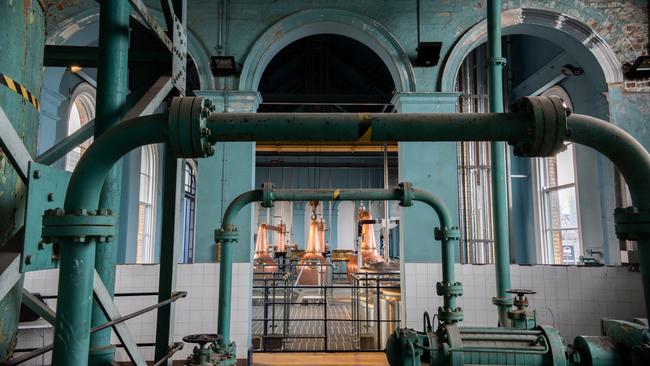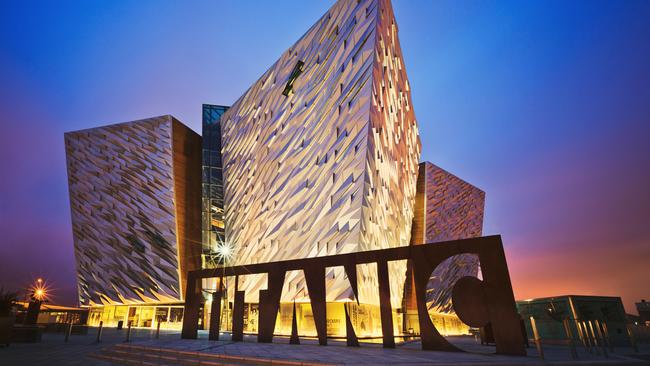Belfast, the city still overshadowed by the Titanic
More than a century on, it is embracing its connections to the world’s most famous shipwreck.

Lifestyle
Don't miss out on the headlines from Lifestyle. Followed categories will be added to My News.
She mentions it almost flippantly as we enter the dining room for breakfast at the Hilton Belfast: “My grandfather worked on the Titanic.” It was the second morning that greeter Christine Rankin was showing us to our table for the breakfast buffet.
“He was born in 1896, so he wouldn’t have been more than 16 when the ship sailed,” she says proudly of her ancestor, Christopher Winchester.

She tells us he was a rivet catcher, and if Christopher was 16 when the ship of dreams sailed, Christine speculates he was likely working for shipbuilders Harland & Wolff from about the age of 12.
These workers caught the rivets that had been heated in the fire below and hammered them into the ship’s hull. If the riveter was working too high above the fire to have the rivet thrown up to him, a young boy had to dash up the scaffolding to deliver the hot rivet before it cooled – a thankless and dangerous job usually given to the youngest and most nimble boys on the job.
Inside the Hilton’s dining area, another nod to the Titanic can be found on the ceiling and walls which have been expertly designed as replicas of the first-class dining lounge on the famous ship.
Christine’s story is a nice reminder that Belfast is still very much a city with close links to the ship, which sank 112 years ago, in 1912. And nowhere is that link more obvious to visitors than in the billion-dollar Titanic Quarter, one of Europe’s largest waterfront regeneration projects.

I couldn’t hide my excitement checking in to the Titanic Hotel Belfast. I can’t remember the exact moment I became a Titanophile, but I know it was in my primary-school years and I’m sure it was a love inspired by my late model shipbuilding dad. When I recently discovered there was a Titanic Hotel in the Belfast building that was once the headquarters of Harland & Wolff, who designed and built the ship, I knew I had to visit.
In fact, it is this hotel that prompted a four-day detour to Belfast on a recent family trip to the UK.
The idea of a themed hotel usually elicits images of kitsch or gaudy finishes but this hotel, which opened in 2017 at a cost of $55 million, is anything but. The centrepiece of the restoration is the grand bar in what was once Drawing Office Two, while guest rooms are designed with Art Deco features and subtle nautical touches. It’s not meant to be a replica of the Titanic; rather a nod to the glamour of a trans-Atlantic voyage. And the fact it’s in a restored historic building means rooms come with extra-high ceilings, tonnes of space and large picture windows.
Belfast hasn’t always embraced its Titanic past. Until the cutting-edge Titanic Belfast exhibition was built in 2012, that important maritime history was all but ignored. Our guide, Susie Millar, says around the time Harland & Wolff closed their offices in the late 1980s, items from the famous building would turn up in skip bins. Millar – who wears a pendant containing a tiny piece from the hull of the Titanic around her neck and who bought the Belfast home of a chief Harland & Wolff draughtsman, Roderick Chisholm – was one beneficiary. She retrieved ship rivets, company ledgers and even a book of fines, which included one for her great-grandfather, who worked for the company, for taking a tea break 20 minutes ahead of time.

Today, the Titanic Quarter is a thriving tourist attraction. Its newest addition, the recently opened Titanic Distillers, is housed inside the restored Pumphouse, which brought water in and out of the neighbouring Thompson Graving Dock, a massive basin custom built in 1911 to hold the Titanic during her fit-out. It was the only dock in the world big enough for the job.
A visit to the distillers combines a tour of the Pumphouse, a lesson on Irish whiskey making, the history of the building and, of course, a tasting. The distiller, the first opened in Belfast in 90 years, is a welcome addition to the region which, in the 1700s, was home to hundreds of whiskey producers who, like shipbuilders, had all but disappeared by the 1980s.
The beating heart of the Titanic Quarter is the $200 million Titanic Belfast, a state-of-the-art exhibition that brings to life the full story of the Titanic through 11 experiences, from Belfast’s emergence as the shipbuilding capital of the world to passenger life on-board the Titanic, the fateful collision with the iceberg, the loss of life, the quest to locate her in 1985 and the still prominent representation of the ship in popular culture. It cements the idea that Belfast was the Titanic’s home and if you listen to the locals, they’ll still tell you, “She was fine when she left here.”
We wander through the self-guided experience – where the new additions include a deck chair, life vest and violin recovered from the ship – while Susie waits at the end. She’s standing by a plaque of a man named Thomas Millar, a then recently widowed engineer who worked on the Titanic and then boarded her for a new life in America, leaving behind his two young sons for a short time while he set up a new home.

“He was my great-grandfather,” Susie says solemnly. We’d spent most of the day with her but she left this important part of her Titanic story to the very end, giving the news a piercing poignancy.
“His wife, Jeannie, died just before Titanic sailed,” she says. “So Thomas signed up as an assistant deck engineer on her maiden voyage. Before he left he gave his sons, Thomas Jr and my grandfather Ruddick, two shiny pennies each and told them not to spend them until he saw them again.”
Thomas Millar went down with the ship on April 15, 1912. And Susie has her grandfather’s two pennies.
The writer was a guest of Tourism Northern Ireland.
Originally published as Belfast, the city still overshadowed by the Titanic





